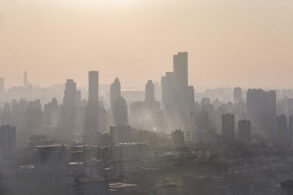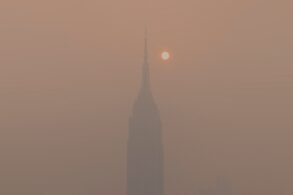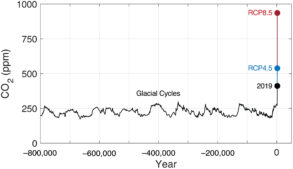
This article was contributed as part of BuiltWorlds’ Verified Contributor Program.
Are you indoors? Take a listen. Notice the ambient noise around you. Are there people talking? Maybe there’s construction outside, birds chirping, a lawn mower, or kids enjoying the summer. While this is a grounding exercise in meditation, that’s not the only purpose. If you focus past the sharpest noises, you may hear the persistent hum of an air conditioner, the whir of a fan, or the low hush of air from a central HVAC unit.
The built environment produces many challenges in the crusade against climate change, but it may also provide overlooked opportunities. When my cofounder and I came together in 2019, we wanted to address the abundance of carbon dioxide in the atmosphere in a way that leveraged our backgrounds in chemical engineering and climate science but also involved the communities that would be most affected by shifting conditions. One of the largest challenges of direct air carbon capture is energy usage, and another is infrastructure. We wanted to find a way to leverage existing buildings, solve more immediate pain points for people and make carbon capture energy-positive.
The problem: Buildings ‘single-use’ ventilation systems are energy-inefficient and ill-prepared for the future
Ventilation in large buildings (commercial and multi-family residential) works on the simple assumption that outdoor air is “fresh.” Thus, ventilation is the main method used to expel contaminants from indoor air, including carbon dioxide (CO2), volatile organic compounds (VOCs), particulate matter and pathogens, such as bacteria and COVID-19. When a building is ventilated, air is exhausted to the outside, and new air is brought in. The new air needs to be treated to the correct temperature and humidity, as well as pre-filtered so it doesn’t bring in too much of the outdoor contamination. This process is very energy intensive—the energy required to ventilate, heat, and cool new air already makes up about 40% of a building’s total energy usage and about 26% of global emissions. The amount of energy increases when additional filtration is added to prevent smoke, smog and allergens from entering a building.
Most Americans spend 90% of their time indoors, so solving for ventilation systems’ inefficiencies, and improving indoor air, is an untapped opportunity at the intersection of health, equity and climate that could address a massive amount of CO2 without the need for capital-intensive new infrastructure.
Increased pollution calls for new solutions

As temperatures become more extreme and outdoor pollution levels increase, buildings consume more and more energy to ventilate and filter the air, increasing the grid pressure. Californians are familiar with this phenomenon, but Eastern Canada and the Northeast US only recently experienced a ventilation challenge related to wildfire smoke. The outdoor air was polluted, so building operators and people in their homes were encouraged not to ventilate. They were left with no way to expel the contamination originating from the indoor environment, including CO2, dust, viruses, bacteria and VOCs from furniture and clothing.
With no ventilation, people turn to traditional air purifiers to rid the air of contaminants, but those are not equipped to capture CO2, a proven contaminant continuously ignored by “solutions” for indoor air quality. Studies have shown that CO2 directly affects our health and well-being, and it builds up surprisingly quickly indoors. An Oklahoma teacher conducted an experiment and gathered 30 students in one classroom. With the door closed, CO2 levels reached 4,825ppm, more than six times the ideal level of CO2 concentration. In California, researchers found that about 85% of 94 recently installed HVACs in K-12 classrooms did not ensure adequate ventilation, which means higher CO2 concentration, and therefore lower grades, increased absenteeism, and worsened asthma, allergies and lung health. Lawrence Berkeley National Lab has found that a 1000 ppm increase in indoor CO2 levels can be associated with a 10-20% increase in student absenteeism.

CO2 capture: The future of health and equity
Indoor CO2 capture can address the health effects described above, but it can also function as a positive feedback on building energy usage and operating costs. When combined with other types of indoor air purification, indoor CO2 capture has the potential to save 36-72% of ventilation loads during peak cooling months. Reduced indoor CO2 levels also hold the potential to enhance productivity, a factor that would outweigh the expenses of any retrofit for companies concerned about their bottom line.
From a climate justice perspective, poor indoor air quality disproportionately affects marginalized communities with higher air pollution rates, access to older and more obsolete infrastructure that consumes more energy, and increased needs for cooling. We have the opportunity to not only reduce our carbon footprint, but to improve millions of people’s health, provide access to better education, and enable building owners to direct the savings to facility improvements, or other investments that directly benefit communities that have been historically left behind.
Everything counts: From audit to retrofit
Eighty percent of buildings that will exist in 2050 already exist. There are plenty of solutions out there that do not require ripping out existing infrastructure to start reducing CO2 and improving health.
Measuring energy consumption is the first tangible step toward reducing energy use. There are several solutions to measure energy inefficiency in buildings:
- Kestrix uses drones and AI to identify energy leaks and spot retrofit needs.
- AccuEnergy designs breaker panel metering for industrial customers.
- Bayou Energy provides the digital infrastructure for energy providers to help customers save money by switching to clean energy.
- Educational resources for buildings and facility managers to audit their HVAC efficiency, provided by organizations such as ASHRAE, USGBC and the Green Building Alliance.
- Measurement, reporting and verification (MRV) platforms are also essential players to show progress on climate goals and unlock further financing of climate solutions.
At Carbon Reform, we took the path of designing a technology that taps into the key ingredients of carbon capture already present in HVAC systems: moving air, concentrated CO2 and excess energy usage. Our Carbon Capsule attaches to the return air of an HVAC system, diverting the air and purifying it from unhealthy aerosols, permanently sequestering CO2 in the process.
Activism is paramount; Technology won’t solve the whole problem
Here are ways you can easily support this air quality solution:
- Support local regulation that induces on-site energy efficiency upgrades, like the NYC Law 97.
- Talk to your office building manager about the IRA Section 179D, an energy efficiency tax deduction for commercial building owners.
- Educate university or school teachers about the importance of air quality in classrooms.
Materials engineer and climate scientist Jo Norris is co-founder and CEO of Carbon Reform. If you’d like to talk to the company about energy efficiency in buildings, decentralized carbon capture and democratizing access to clean air, reach out to team@carbonreform.com.

Discussion
Be the first to leave a comment.
You must be a member of the BuiltWorlds community to join the discussion.